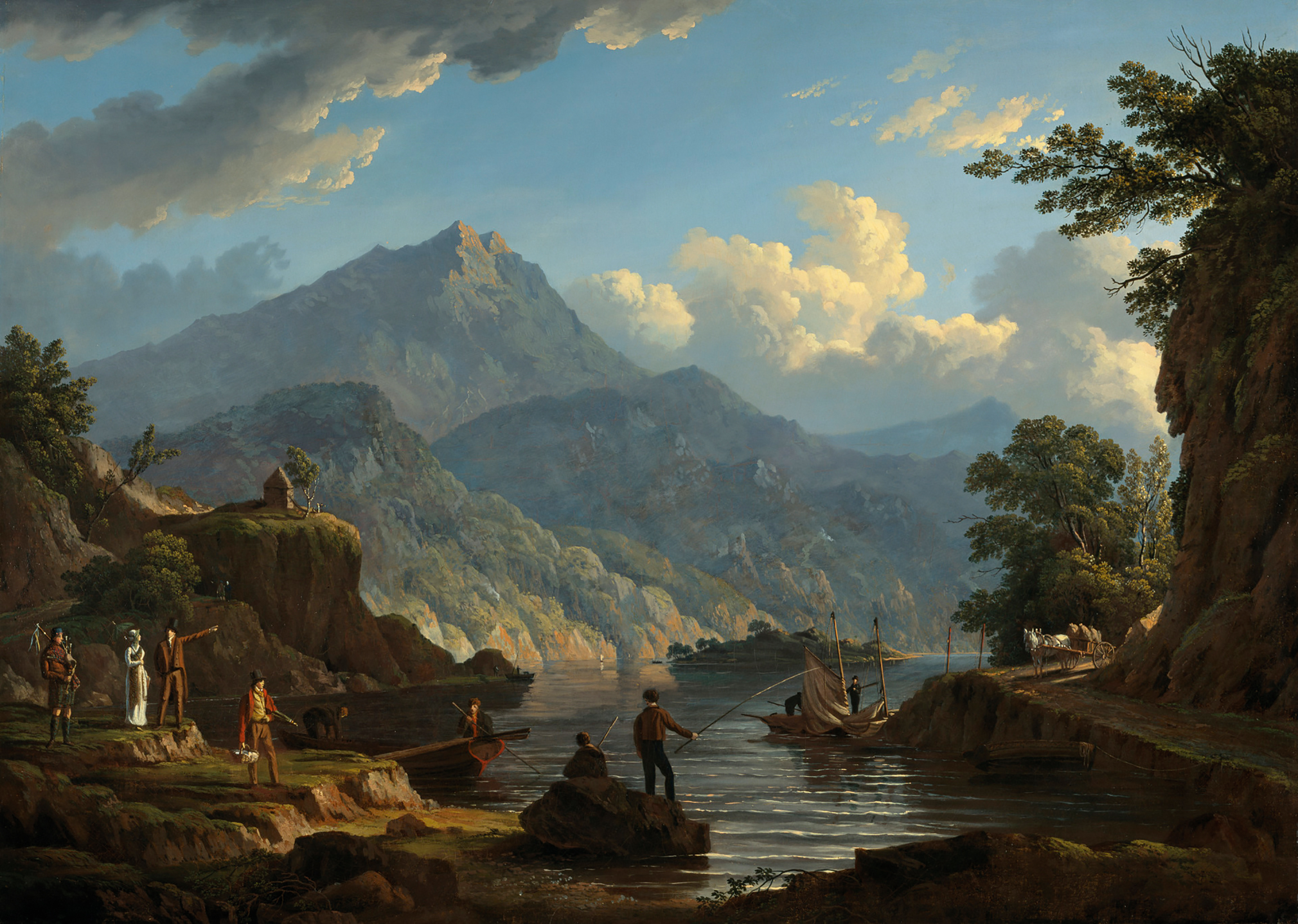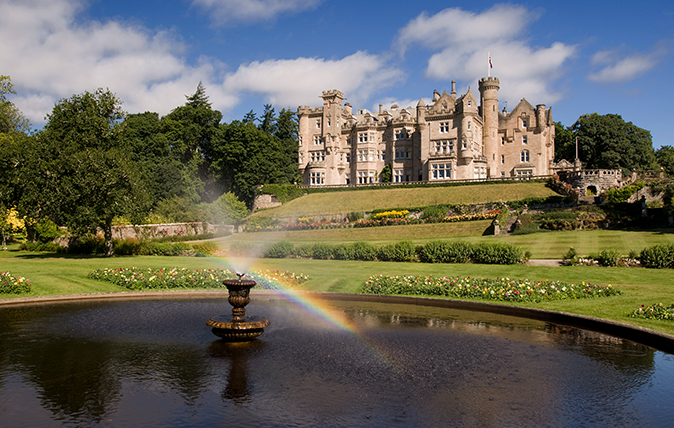In Focus: The wild visions of Scotland which made it 'a playground for the rich' as the native Gaels faced typhoid, famine and eviction
Mary Miers visits the National Museum of Scotland's latest exhibition, 'Wild and Majestic: Romantic Visions of Scotland', and sees how as native Gaels faced typhoid, famine and eviction, their homeland was turned into a playground for the rich, the ancient culture sentimentalised by Scotch-themed decor and kitsch souvenirs.


Publicised with a Classic FM commercial in mellow, Rob Roy brogue, the National Museum of Scotland’s new blockbuster is a smooth distillation of Highland history, from the 1746 Jacobite debacle to the death of Queen Victoria.
Taking for its title a quote from Byron’s Lachin Y. Gair, ‘Wild and Majestic’ looks at how the landscape and culture of the Highlands and Islands were appropriated during the Romantic movement to provide Scotland with an alluring national identity that endures to this day.
If the balance of the exhibition is somewhat weighted towards costume and arms — with such themes as the architecture of Romantic revivalism and the Celtic Revival absent or barely touched on — it reflects the strengths of the museum’s collections, from which the majority of the displays are drawn. The show may contain little that is new, but it provides a concise and balanced overview of a complex subject whose many paradoxes are too often veiled in mist.
Audio-visuals, some in Gaelic, elaborate on certain themes and a short film on the ’Forty Five adds historical context. It points out that, contrary to popular assumption, the Jacobite wars did not introduce, but merely accelerated, the social and economic changes that, by the 18th century, were already transforming the Highland way of life.

By the later 18th century, the region was in crisis, morale further dented by Hanoverian reprisals, military occupation and the suppression of aspects of Gaelic culture and society. Tartan and weapons were proscribed, Jacobite lands forfeited, clan chiefs stripped of their powers of jurisdiction.
Simultaneously, efforts were made to ‘civilise’ the Highlands, with new villages, roads and harbours and the creation of rural industries to boost the economy.
A further irony shadowed efforts to implement agricultural reform, as it was the very farming methods pursued by improving landlords that precipitated the further social upheaval of the Clearances.
Exquisite houses, the beauty of Nature, and how to get the most from your life, straight to your inbox.
'The idealisation of the clansman in his wild mountain terrain was all part of a contemporary fascination with the "primitive"'
The transformation of the image of the Gael is a central theme. In barely a few decades, the barbaric rebel would become a martial hero, fêted for his bravery fighting for the British Empire and bringing a glamour to the image of the Highland soldier, whose exotic regalia, so recently banned as symbolic of rebellion, would stimulate a new interest in tartan dress and bagpipe music.
The show is strong on this military culture, with exhibits relating to the recruitment into the British Army of Highland regiments — the first, the Black Watch, was formed in 1739 — and of companies raised by landowners. Their picturesque attire would evolve into Scotland’s national costume.
The idealisation of the clansman in his wild mountain terrain was all part of a contemporary fascination with the ‘primitive’ and new theories in aesthetic taste. Ringing with legends of Celtic heroes and the tragic romance of Jacobitism, dramatised by rugged castles and geological wonders, the landscape that had so recently repelled foreigners now drew visitors in search of the Sublime.
Then came the Picturesque tourists, with their sketchbooks and copies of Ossian and The Lady of the Lake, seeking out places of natural beauty and sites of literary association. Following in the footsteps of Dr Johnson, Burns and Scott came Keats and Wordsworth, Turner, Mendelssohn and other European Romantics, whose works of art, literature and music helped to popularise the Highland Tour.
Meanwhile, chieftains had themselves painted as feudal patriarchs in full Highland plumage, ignoring the irony that they were now Anglicised modern landlords. The blend of Romantic sentiment and Enlightenment values that colours this period — encapsulated in James Macpherson’s adaption of Ossian as the Celtic Homer — was nowhere more vividly expressed than in Pompeo Batoni’s swagger portrait of Col William Gordon of Fyvie, a Highland warrior transported to Classical Rome, his plaid draped across his body like a toga.
Tartan, with all its complex political symbolism, became a fashion fabric after the ban was lifted in 1782, worn by a widening sector of society — although, notably, not by crofters — and codified into patterns identified exclusively with individual clans. Wilson & Sons of Bannockburn, founded in the 1760s, were at the forefront of the tartan-revival industry, weaving high-quality cloth that, by the 1820s, was being exported across the world.
A key stimulus in popularising this badge of Scottish identity was George IV’s visit to Edinburgh in 1822, a pageant of tartanry that was orchestrated by Scott. Much satirised and controversial at a time of widespread discontent, the elaborate celebrations were intended to symbolise Scotland’s national distinctiveness, as well as emphasising loyalty to the Union.
'As native Gaels faced typhoid, famine and eviction, their homeland was turned into a playground for the rich, the ancient culture sentimentalised by Scotch-themed decor and kitsch souvenirs'
Queen Victoria and Prince Albert strengthened the royal connection. Staying at Taymouth Castle in 1842, they were treated to a spectacle of piping, torchlight displays of Highland dancing, parades, a deer hunt and Gaelic song in a setting that blended Highland imagery with neo-Gothic taste. For the Queen, it was ‘like the reception in olden feudal times, of the Sovereign by a chieftain. It was truly princely & romantic’. She resolved to get herself a personal piper.
Balmoral, which they first visited in 1848, would become the embodiment of the royal love affair with the Romantic North. Weaned on Scott’s novels, they built a new castle, stalked and made mountain expeditions, hosted gillies’ balls and draped themselves and their servants in tartan, lending royal cachet to a version of the Highland experience already enjoyed by the upper classes and soon to be embraced by plutocrats and tycoons.
And so, as native Gaels faced typhoid, famine and eviction, their homeland was turned into a playground for the rich, the ancient culture sentimentalised by Scotch-themed decor and kitsch souvenirs.
So where are the real Highlanders in this story? The answer is, off-stage. The truth is that this whole phenomenon was a fantasy driven by the privileged and intellectual Romantics, who yearned for an idealised Gaidhealtachd yet also (with some exceptions) turned a blind eye to the ordinary contemporary crofters and the harsh realities of their lives.
Even those who promoted scholarly research and the preservation and promotion of genuine Gaelic culture were mostly aristocrats and gentry — the members of newly formed Highland societies and clubs, many resident in the South.
For all the controversies enmeshed in this subject, few could deny, however, that the adoption of a romanticised Highland identity for Scotland was a triumph of PR image-branding that is still the envy of the world.
'Wild and Majestic: Romantic Visions of Scotland' is at the National Museum of Scotland until November 10 — www.nms.ac.uk

Credit: Skibo Castle
Highland Retreats review: Proof that shooting lodges that aren’t all freezing monstrosities
A new book by Mary Miers, Country Life's fine arts and books editor, had Adam Nicolson gripped.

Credit: Simon Jauncey
Torosay Castle: The Hebridean shooting lodge that stayed in one family for 150 years
Mary Miers tells the story of a Victorian shooting lodge owned by the same family for 147 years – with

Credit: Savills
The estate of 'the beautiful Duchess of Gordon', a Highland gem of national importance
A county retreat from the London Season, the summer residence of a powerful political hostess in the 19th century has
Mary Miers is a hugely experienced writer on art and architecture, and a former Fine Arts Editor of Country Life. Mary joined the team after running Scotland’s Buildings at Risk Register. She lived in 15 different homes across several countries while she was growing up, and for a while commuted to London from Scotland each week. She is also the author of seven books.
